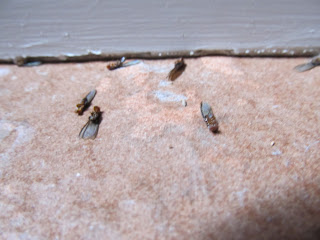 |
| Drywood termite swarmers in Phoenix |
Drywood termites in Phoenix
August 2, 2012 – Lisa Gartner of Bill’s
Pest Termite Control reports an increase in calls reporting “flying ants” or “flying
termites” from concerned homeowners across the valley. Termite Inspectors responding to these calls
are often finding evidence of Western Drywood Termites a sign that the summer
swarm season is underway in Metro Phoenix
Western Drywood Termites are often misidentified
as ant swarmers by less experienced exterminators. Drywood termites and ants
share similar swarm seasons in Arizona.
It generally takes 4-7 years for drywood termites to produce swarmers so
their presence is a sign of a mature colony nearby.
Generally, the first sign of
infestation is the discovery of cone shaped piles of fecal pellets or the
presence of winged swarmers on windowsills, door frames or near lights. Discovery
of damage is usually secondary. Swarmers found inside the house (if windows and
doors have been closed), are an indication of infestation within the structure.
Another indication of infestation is the presence of discarded wings near
emergence sites, on windowsills or caught up in cobwebs. The presence of swarmers
outdoors is a natural phenomenon and is not necessarily an indication of home
infestation.
Drywood termites in Phoenix spend their entire lives inside wood. They construct round “kick holes” in infested
wood, through which the fecal pellets are pushed from their galleries or
tunnels. These pellets accumulate in small piles below the kick holes, or will
be scattered if the distance between the kick hole and the surface below is
very great. Fecal pellets also may be found caught in spider webs.
Fecal pellets are distinctive and used
for identification of drywood termite infestation. Drywood fecal pellets are
hard, elongated and less than 1/25 inch long. They have rounded ends and six
flattened or concavely depressed sides with ridges at angles between the six
surfaces. The characteristic shape results when the termite exerts pressure on
the fecal material to extract and conserve moisture in its hindgut. Typically
the pellets are a light tan in color with some black ones mixed in.
Homeowners are encouraged to have their home inspected for termites at least once a year by a professional
familiar with all species of termites Arizona.
Drywood termites in Phoenix
602.308.4510

No comments:
Post a Comment